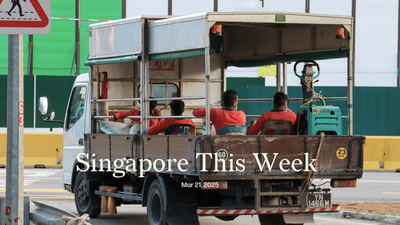Society: Covid heroes
As we continue to emerge from the worst of the pandemic, it’s important to reflect on the labour that helped us through it. Singapore will recognise over 100,000 people for their efforts, giving national awards to around 9,500. Three will get the top “Covid-19 National Award”: Kenneth Mak, Singapore’s director of medical services, who oversaw the public health response; Pang Kin Keong, permanent secretary at the Ministry of Home Affairs, who, as head of the Homefront Crisis Executive Group, coordinated the work of Singapore’s public, private and community sectors; and Tan Chong Meng, head of PSA International, who among other things helped secure vital supply chains and led the setting up of emergency health infrastructure during the pandemic’s first wave, including certifying Expo as a medical facility within days. Other notable work included that of Caroline Yang, president of the Singapore Shipping Association, who set up “SeaVax”, through which over 1,000 foreign seafarers who visited Singapore were vaccinated. (In the pandemic’s early days, some 400,000 seafarers globally were stranded at sea, unable to go ashore.) Meanwhile, 30 people from Scoot, Raffles Medical Group, and the Ministry of Foreign Affairs will receive the Medal of Valour (Covid-19) for scooting over 200 Singaporeans and their families out of Wuhan, China, the virus’s epicentre, in January and February 2020. Scoot’s station manager said that the hardest part of her job was turning away symptomatic passengers. As outbound travel from China resumes, many Singaporeans will be hoping for similar vigilance.
Society: Other Singaporeans we cheered
The eighth edition of The Straits Times Singaporean of the Year award offers a peek into Singaporean benevolence in 2022. Nominees include: Charanjit Singh Walia, 65, and Priveen Suraj Santakumar, 34, who cooked free meals for Ukrainian refugees in Poland; Anson Ng, 55, who pays for the funerals of strangers and helps fulfil the last wishes of those on their deathbeds; Khairiah Hanim Mazlan, 44, a former prison officer (who interacted with suicidal inmates) turned Gojek driver, who engages passengers in mental health conversations, and in 2021 talked one passenger out of killing herself; Alison Lim, 65, and Anjang Rosli, 58, who have young-onset dementia, and have used their experiences to support others with disabilities; and Moonlake Lee, 53, who was diagnosed with attention deficit hyperactivity disorder (ADHD) in 2018 and founded the Unlocking ADHD organisation in 2021. If you aren’t feeling too inadequate by now about your own selflessness—or lack thereof—please vote for one of the nominees by 7pm January 7th.
Society: The birds and the bees, post-repeal
Singapore’s sex education syllabus has long promoted abstinence before marriage in support of the traditional heterosexual family unit. But how should the syllabus reflect the recent decriminalisation of gay sex? According to the Ministry of Education (MOE), the scope of sex education covers “[teaching] students what homosexuality is and the importance of mutual understanding, respect and empathy for everyone.” But students have reported that “there’s no mention of any LGBTQIA topics in [their] classes.” This erasure of the LGBTQ+ community keeps queer sex and relationships taboo, with social and public health implications. Combined with a strong, abstinence-based approach, young Singaporeans (regardless of sexual orientation) are often left ill-equipped and uninformed. “My students don’t know where they can get contraception from, they don’t know what the options are, or they think contraception maybe only lies in the hands of the guy and not the girl,” a teacher told TODAY. In Parliament, Masagos Zulkifli, the minister for social and family development, maintained that the current syllabus “remains secular and based on research and evidence.” Yet there are no secular reasons or evidence to support such a strong focus on abstinence and the erasure of queer issues. (There are plenty of religious ones.) Students themselves have expressed a desire for more comprehensive sex education that is “non-judgemental” and tells them “how to practise safe sex and understand the consequences of [their] actions”. Perhaps MOE should pay less attention to older, religious conservatives and more to the real needs of younger Singaporeans. They want a curriculum that tells them more than just “sex is bad”.
Arts: The January frenzy
The second week of the year just might be the busiest in the arts calendar. Apart from the packed programme of Singapore Art Week (SAW), art lovers can look forward to work across genres like film, literature, and visual art:
- Light to Night is presented in conjunction with SAW but is an institution of its own. The festival is best known for the light installations and façade projections that illuminate the Civic District. This year’s programme also features panel discussions, live music, and even a trivia night.
- Textures is The Arts House’s Singapore literature festival and boasts over 30 activities this year. Programmes include “A Novel Idea” (a dramatised reading of three SingLit novels), “Re-turning” (a multilingual poetry reading and calligraphy performance) and “Dwelling” (an art installation). Homebodies can take advantage of Read At Home, the National Library Board's curated selection of eBooks.
- Miss the ‘90s or wish you were alive for them? “Class Acts”, a documentary about Singapore’s creative scene in the ‘90s, is playing at the National Design Centre on January 14th. The film features creative pioneers from design, underground music, street art, and cultural institutions like The Substation and Zouk. Those who can’t catch the film screening can still visit the accompanying exhibition until January 31st.
Arts: Singapore’s booming art market
For some, a cost of living crisis. For others, a perfect time to get into art collecting. A recent story by ARTnews detailed how three international galleries are setting up shop in Singapore. New York’s Lehmann Maupin has just appointed Singaporean Ken Tan to preside over the gallery’s presence in South-east Asia, while Tokyo’s Whitestone Gallery and Hong Kong’s WOAW Gallery are both christening their new spaces with exhibitions, this month. Whitestone’s massive Tanjong Pager Distripark space spans over 13,000 sq ft and opens with two exhibitions: a solo show by Japanese artist Etsu Egami and a group show cheekily titled “We love Singapore”. WOAW’s opening show, “As Friends & Partners,” is a group show curated by Kevin Poon, the Hong-Kong based founder of the gallery. Whitestone opens on January 6th and WOAW opens on January 12th. The GST increase might be hitting most of us but it’s possible that the clientele of these galleries won’t feel it at all.
History weekly by Faris Joraimi
At the stroke of midnight this New Year, photographer Darren Soh tried to document the ships around Singapore’s eastern anchorage (off Marine Parade) as they set off flares to welcome 2023. Nothing happened. Soh later found out that last year Singapore banned this old maritime tradition. It’s not the first nautical New Year spectacle we’ve lost. Up until the 1970s, residents could walk along Beach Road all the way to the Padang and hear the ships in the harbour sounding their foghorns and sirens, as the bells of Saint Andrew’s Cathedral merrily pealed. Anchored close enough to Collyer Quay, vessels were decorated with gay buntings for the enjoyment of city strollers. It was “only in ports like Singapore that you can ring in the New Year in this unique fashion”, remarked New Nation in 1973. And until the late 1960s, the old harbour was also where the New Year Sea Sports were held, including a Malay yacht regatta. Competitors flocked there from Singapore’s Southern Islands and neighbouring Riau, in their handbuilt “kolek” (a fast Malay watercraft), whose elegant sails bobbed on the harbour like seagulls in a pond. The victorious mariner received a princely sum of S$15. Over the decades, as the harbour was progressively reclaimed to eventually become what is now Marina Bay, a concert and fireworks have slowly replaced the boaters. Those 2022 flares may have been their swansong.
Tech: A tale of two sustainable food start-ups
With a staggering 2bn tonnes of food being tossed out each year, it’s clear that something needs to be done about the global food waste crisis. But, what happens when investors don’t provide the capital required for start-ups to change this reality? This week, e-grocery start-up UglyFood announced its plans to wind down after failing to secure the US$1m (S$1.3m) it was looking to raise. The company has been selling ‘ugly’ fruits and vegetables, such as bruised fruits or items that have blemishes, on its platform since 2017. In 2019, Singapore generated more than 744,000 tonnes of food waste, or about 130kg per capita (slightly above the global average of 121kg). Half of that came from fruits and vegetables. In better news, AlterPacks, a Singapore-based food packaging start-up, has just raised US$1m (S$1.3m) in a pre-seed funding round led by Plug and Play APAC and Seed Capital, with Earth Venture Capital and angel investor Alice Foo also joining the table. Founded in 2019, Alterpacks addresses the global problem of single-use plastics, food waste and packaging waste by converting food waste into takeout boxes and other containers. Its main raw material is spent grains, a by-product of the production of foods such as beer, which is typically used for animal feed, fertiliser, or otherwise discarded. Revenues in Singapore’s food waste recycling market are expected to grow from US$18.9m (S$25.3m) in 2020 to US$33m (S$44.1m), by the end of 2030. Circular economy start-ups have unique business model challenges everywhere, more so in a society that has long fetishised newness and perfection. They deserve our support because the few that succeed can make a huge difference in driving more sustainable consumption.
Tech: Carousell scams
It’s no longer buyer beware but seller beware on online marketplaces like Carousell. In December 2022 alone, over 1,115 Carousell sellers fell victim to fraud totaling more than S$1m. This is a disturbing increase from the 975 victims reported in the first 11 months of the year, with reported losses totaling over S$938,000. According to the Singapore Police Force, many of these scams involved fake buyers asking victims to enter their banking information on spoofed websites in order to receive payment. A “significant proportion” of the reports also involved unauthorised overseas PayNow transfers, which can make recovery of funds nearly impossible. In response to these troubling trends, Carousell and the Association of Banks in Singapore (ABS) are implementing measures to protect their customers, including potentially adjusting the mechanism of overseas PayNow transfers. This comes on the heels of a data breach on the platform in October last year that compromised the personal data of some 1.95m users in Singapore. In the end, there’s no denying that online shopping has its fair share of risks. Clearly, Carousell needs to double down to make its platform safer for both its sellers and buyers.
Tech: Singapore’s OG techpreneur passes on
Sim Wong Hoo, founder of Creative Technology, has passed aged 67. A pioneer in Singapore’s technology industry, Sim founded Creative in 1981 in Singapore and served as chairman and CEO until his death. The company initially gained recognition for its audio devices, including the Sound Blaster sound card, which became a household name among computer users. Creative released a range of other popular products, including headphones, speakers, and portable media players. Creative expanded into other areas too, such as digital entertainment and gaming, and also became known for HansVision, its Chinese e-dictionary. Sim took the company public on the NASDAQ in 1992 before undergoing a voluntary delisting in 2007. In 2006, the company made headlines when it settled with Apple for US$100m (S$160m) in a legal dispute over music player patents. Creative’s board has appointed Song Siow Hui, the current president of Creative Labs, as interim CEO. While Creative has declined in prominence over the years, Sim inspired a generation of local entrepreneurs and put Singapore on the world technology map.
If you enjoy Jom’s work, do get a paid subscription today to support independent journalism in Singapore.








